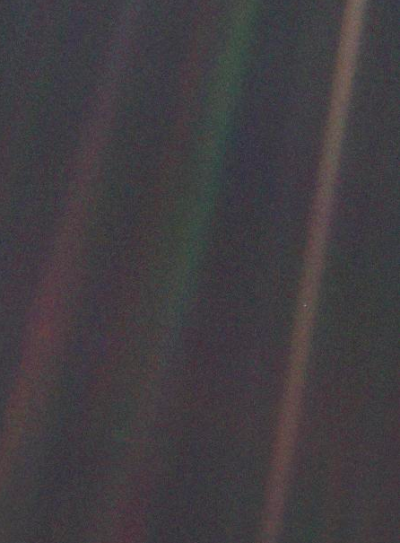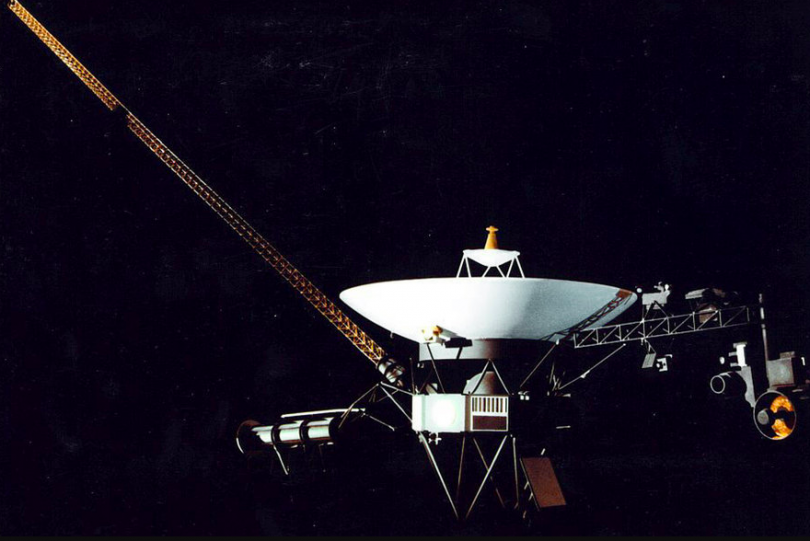aNewDomain — Launched 35 years ago, the Voyager 1 robotic space probe is one of the world’s most successful and unique space exploration missions.
And it’s now the furthest man-made object from Earth.
Voyager 1 continues to send back information back across 11.5 billion miles from as it heads out of the solar system and embarks on an eternal journey through interstellar space.
 The craft’s primary mission was to explore the outer planets of Jupiter and Saturn and their extensive systems of moons. Its highly successful and identical sister craft, Voyager 2, which actually launched a few weeks earlier, set out to explore all of the four outer planets, too.
The craft’s primary mission was to explore the outer planets of Jupiter and Saturn and their extensive systems of moons. Its highly successful and identical sister craft, Voyager 2, which actually launched a few weeks earlier, set out to explore all of the four outer planets, too.
But it’s still Voyager 1 that captivates.
Following is a history of Voyager 1’s fascinating mission of discovery, and a look at its continuing adventure into the lonely depths of the universe.
1977 – Voyager 1 is launched
Voyager 1 was the third space probe to explore the outer planets after Pioneer 10 in 1973 and Pioneer 11 in 1974. After several years of planning, Voyager 1 launched on September 5th, 1977.
Voyager 1 was identical to its sister probe, Voyager 2, weighing 1,592 pounds and powered by three electrical generators which draw their power from the radioactive decay of plutonium-238.
This should be able to provide enough power for the Voyager probes to operate certain instruments until about 2025.
Unlike many other space probes which are powered by solar panels, the Voyager probes needed something more practical due to the enormous distance from the Sun of their mission targets.
In addition to two camera imaging systems and radio telecommunications arrays, the Voyager probes are equipped with a full arsenal of scientific equipment to learn more about their environments and explore the outer planets up close.
Both probes were also equipped with the Voyager Golden Record, gold-plated phonographs containing images and scientific information from Earth should any extraterrestrial civilization pick them up.
Voyager 1 was launched from Cape Canaveral by a Titan-Centaur space rocket and is currently traveling at 10.72 miles per second relative to the Sun.
1977-1978 – Voyager passes through the Asteroid Belt
The Asteroid Belt comprises a vast area containing hundreds of thousands of asteroids and the dwarf planet, Ceres. It extends from near the orbit of Mars to approximately half way to the orbit of Jupiter. In December, 1977, Voyager 1 entered the asteroid belt but, due to the asteroids covering a vast area and being hundreds of thousands of miles apart, there was a negligible chance of it crashing into anything. About a week after passing through the Asteroid Belt, Voyager 1 overtook its sister ship and headed directly for Jupiter.
1979 – Exploration of Jupiter
Voyager 1 became the third space probe to enter the Jovian system in March 1979, after traveling for some 18 months. After arriving on the fifth day of the month, the space probe passed near Amalthea, one of Jupiter’s many small, irregularly-shaped moons.
Voyager 1 reached its closest approach to Jupiter on the same day at a distance of 217 thousand miles.
It continued on to fly by Jupiter’s four largest moons, known as the Galilean Moons; Io, Europa, Ganymede and Callisto. Voyager 1 took many close-up photos of Jupiter and the Galilean Moons during this time.
It also discovered the presence of faint rings around Jupiter. On the thirteenth of April in that year, Voyager 1 left the Jovian system forever and took off for its next stop, Saturn.
1980 – Exploration of Saturn
Voyager 1 became the second space probe to enter the Saturnian system after the Pioneer 11 flyby the previous year. It arrived in the Saturnian system on November 12th of 1980, spending the first day exploring Titan, Saturn’s largest moon and Tethys. It then made its closest approach to the ringed planet at a distance of 114 thousand miles. The following day, it flew by four of Saturn’s other moons, Mimas, Enceladus, Rhea and Hyperion. After photographing the Saturnian system and monitoring the Saturnian climate and atmosphere, Voyager 1 continued out towards deep space and on December 14, 1980, it started on its interstellar mission.
1990 – Going Interstellar
Having completed its primary mission to observe the Jupiter and Saturn and their many moons, Voyager 1 continued towards the edge of the Solar System. On February 14, 1990, Voyager 1 took its last photographs of the solar system — the first ever from a vantage point beyond the planet Neptune.
At a distance of almost 3.8 billion miles, or five times further away than Saturn at its closest position to Earth, it took the famous Pale Blue Dot photo of planet Earth, a pixel-size dot shining out against the sheer vastness of space around it.
It then shut down its camera hardware to conserve power.
Thanks to gravitational assists from Jupiter and Saturn, Voyager 1 continued its journey at 38,120 miles per hour towards interstellar space.
Already, some of its systems have been shut down to conserve power, although many science instruments will remain operating until 2020 when commands will be sent across the immense distances to shut down most of the remaining systems.
Sometime between 2025 and 2030, Voyager 1 will no longer be able to power any instruments and will become a lifeless hunk of metal drifting silently through space having lost contact with Earth.
Today, Voyager 1, despite being more than 35 years old, is still sending information back to Earth via radio waves traveling at the speed of light. It also continues to successfully respond to commands from the control centre back home.
The space probe is so far away that it takes signals more than seventeen hours to cross the vast gap between it and home and those signals are traveling at the speed of light – that’s 186,282 miles per second!
In 2012, Voyager 1 passed through a previously undiscovered area of the Solar System, known as the Magnetic Highway. That marks the edges of the Sun’s magnetic influence on outer space.
By year’s end, Voyager 1 passed through the heliosheath and headed out into the unimaginably vast void of interstellar space.
Voyager 1 is not headed towards any particular star, although it will be about 1.6 light years from Gliese 445 in about 40,000 years, but this star is also moving towards our solar system as well. If it were heading directly towards the nearest star to Earth, Alpha Centauri, 4.3 light years away, it would take 76,000 years to get there, in spite of traveling almost eleven miles per second. In 296,000 years, Voyager 1 will be 4.3 light years from the brightest star in the night sky, Sirius.
Since space is largely completely empty to all intents and purposes, Voyager 1 will continue to drift onward unharmed and deeper out into the interstellar medium.
One of the most fascinating considerations is that the space probe will likely be around for millions upon millions of years, long after humanity has ceased to exist and all life on Earth has died its natural death long before, no longer leaving any trace of its existence.
Voyager 1 and space probes like it will likely be the only trace of humanity’s existence in the vast universe. The chances of it ever crashing into anything are extremely low and, in fact, the chances of some extraterrestrial civilization finding it and picking it up are perhaps more realistic.
In the most recent news Nasa has fired Voyager 1’s engines for the first time in 37 years! Voyager 1 continues on its eternal mission through the stars, wandering lonely onwards at unspeakably huge distances from home.
Visit Winchester Science Centre to learn more about space through a wide a range of science exhibits including dedicated space planetarium shows and movies.
For aNewDomain, I’m Max Zachary.













